Hyundai Elantra Touring 2011 User Guide
Manufacturer: HYUNDAI, Model Year: 2011, Model line: Elantra Touring, Model: Hyundai Elantra Touring 2011Pages: 402, PDF Size: 37.54 MB
Page 11 of 402
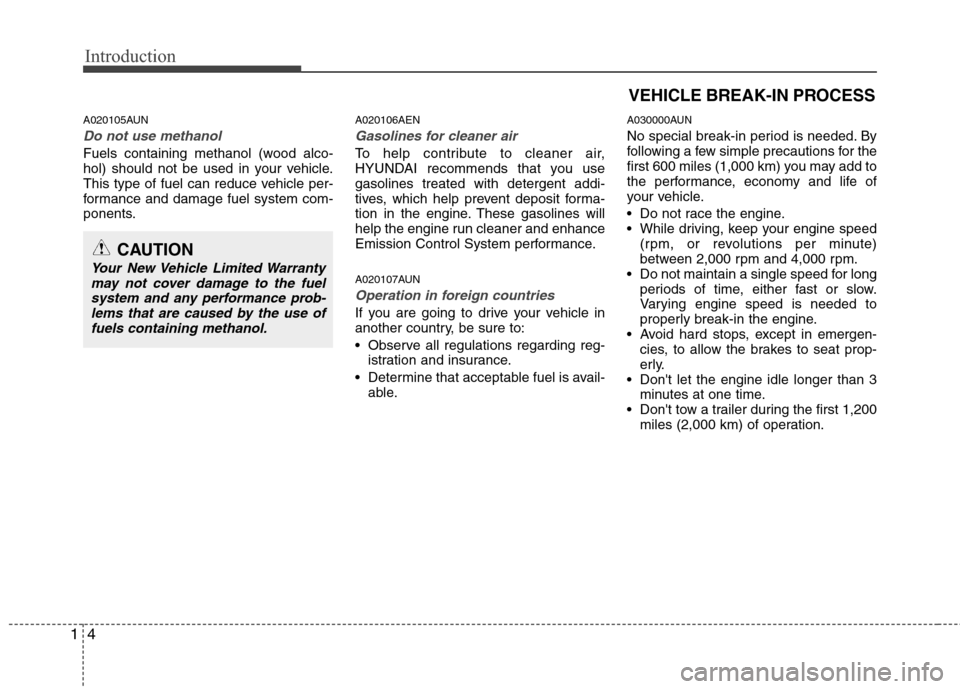
Introduction
4 1
A020105AUN
Do not use methanol
Fuels containing methanol (wood alco-
hol) should not be used in your vehicle.
This type of fuel can reduce vehicle per-
formance and damage fuel system com-
ponents.
A020106AEN
Gasolines for cleaner air
To help contribute to cleaner air,
HYUNDAI recommends that you use
gasolines treated with detergent addi-
tives, which help prevent deposit forma-
tion in the engine. These gasolines will
help the engine run cleaner and enhance
Emission Control System performance.
A020107AUN
Operation in foreign countries
If you are going to drive your vehicle in
another country, be sure to:
Observe all regulations regarding reg-
istration and insurance.
Determine that acceptable fuel is avail-
able.
A030000AUN
No special break-in period is needed. By
following a few simple precautions for the
first 600 miles (1,000 km) you may add to
the performance, economy and life of
your vehicle.
Do not race the engine.
While driving, keep your engine speed
(rpm, or revolutions per minute)
between 2,000 rpm and 4,000 rpm.
Do not maintain a single speed for long
periods of time, either fast or slow.
Varying engine speed is needed to
properly break-in the engine.
Avoid hard stops, except in emergen-
cies, to allow the brakes to seat prop-
erly.
Don't let the engine idle longer than 3
minutes at one time.
Don't tow a trailer during the first 1,200
miles (2,000 km) of operation.
VEHICLE BREAK-IN PROCESS
CAUTION
Your New Vehicle Limited Warranty
may not cover damage to the fuel
system and any performance prob-
lems that are caused by the use of
fuels containing methanol.
Page 12 of 402
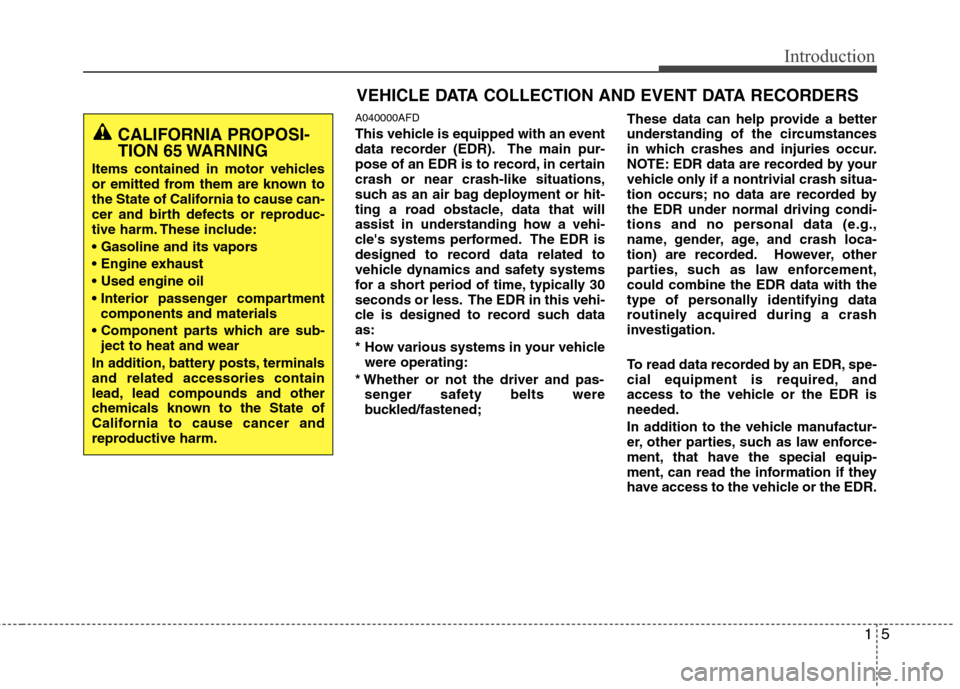
15
Introduction
A040000AFD
This vehicle is equipped with an event
data recorder (EDR). The main pur-
pose of an EDR is to record, in certain
crash or near crash-like situations,
such as an air bag deployment or hit-
ting a road obstacle, data that will
assist in understanding how a vehi-
cle's systems performed. The EDR is
designed to record data related to
vehicle dynamics and safety systems
for a short period of time, typically 30
seconds or less. The EDR in this vehi-
cle is designed to record such data
as:
* How various systems in your vehicle
were operating:
* Whether or not the driver and pas-
senger safety belts were
buckled/fastened;These data can help provide a better
understanding of the circumstances
in which crashes and injuries occur.
NOTE: EDR data are recorded by your
vehicle only if a nontrivial crash situa-
tion occurs; no data are recorded by
the EDR under normal driving condi-
tions and no personal data (e.g.,
name, gender, age, and crash loca-
tion) are recorded. However, other
parties, such as law enforcement,
could combine the EDR data with the
type of personally identifying data
routinely acquired during a crash
investigation.
To read data recorded by an EDR, spe-
cial equipment is required, and
access to the vehicle or the EDR is
needed.
In addition to the vehicle manufactur-
er, other parties, such as law enforce-
ment, that have the special equip-
ment, can read the information if they
have access to the vehicle or the EDR.CALIFORNIA PROPOSI-
TION 65 WARNING
Items contained in motor vehicles
or emitted from them are known to
the State of California to cause can-
cer and birth defects or reproduc-
tive harm. These include:
components and materials
ject to heat and wear
In addition, battery posts, terminals
and related accessories contain
lead, lead compounds and other
chemicals known to the State of
California to cause cancer and
reproductive harm.
VEHICLE DATA COLLECTION AND EVENT DATA RECORDERS
Page 13 of 402
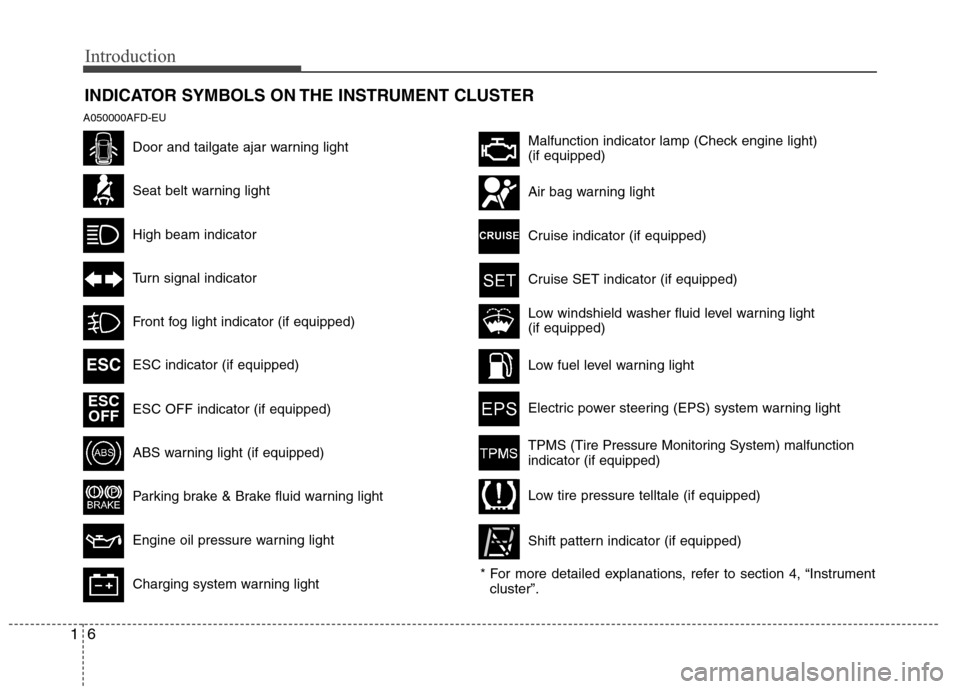
Introduction
6 1
INDICATOR SYMBOLS ON THE INSTRUMENT CLUSTER
A050000AFD-EU
Door and tailgate ajar warning light
Seat belt warning light
High beam indicator
Turn signal indicator
Front fog light indicator (if equipped)
ESC indicator (if equipped)
ABS warning light (if equipped)
Parking brake & Brake fluid warning light
Engine oil pressure warning light
Charging system warning light ESC OFF indicator (if equipped)
Malfunction indicator lamp (Check engine light)
(if equipped)
Air bag warning light
Cruise indicator (if equipped)
Cruise SET indicator (if equipped)
Low fuel level warning light
Electric power steering (EPS) system warning light
Low windshield washer fluid level warning light
(if equipped)
* For more detailed explanations, refer to section 4, “Instrument
cluster”.
TPMS (Tire Pressure Monitoring System) malfunction
indicator (if equipped)
Low tire pressure telltale (if equipped)
Shift pattern indicator (if equipped)
ESC
ESC
OFF
Page 14 of 402
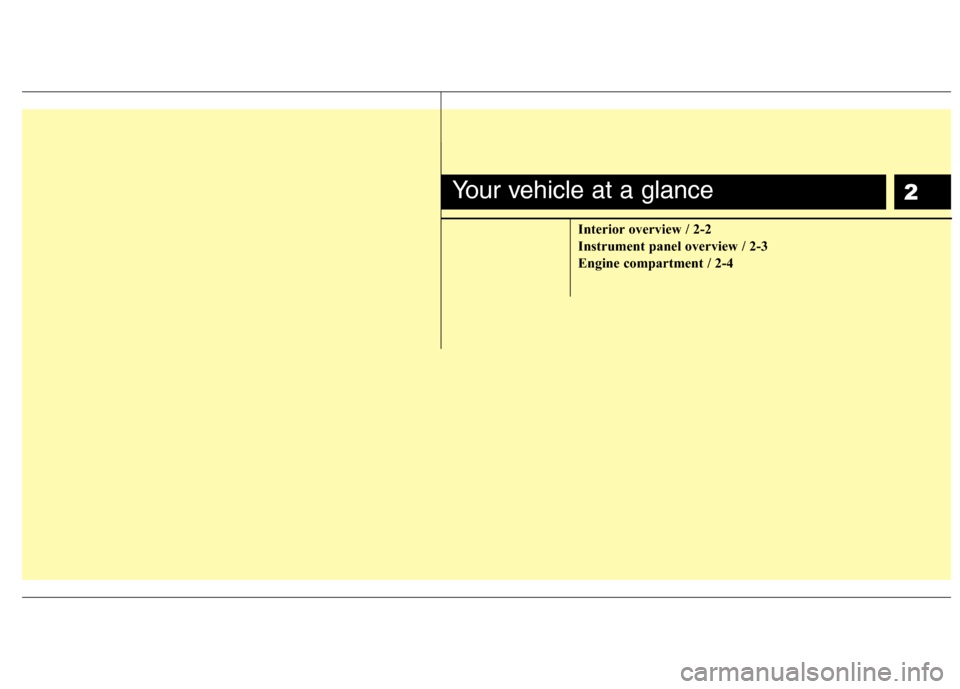
2
Interior overview / 2-2
Instrument panel overview / 2-3
Engine compartment / 2-4
Your vehicle at a glance
Page 15 of 402
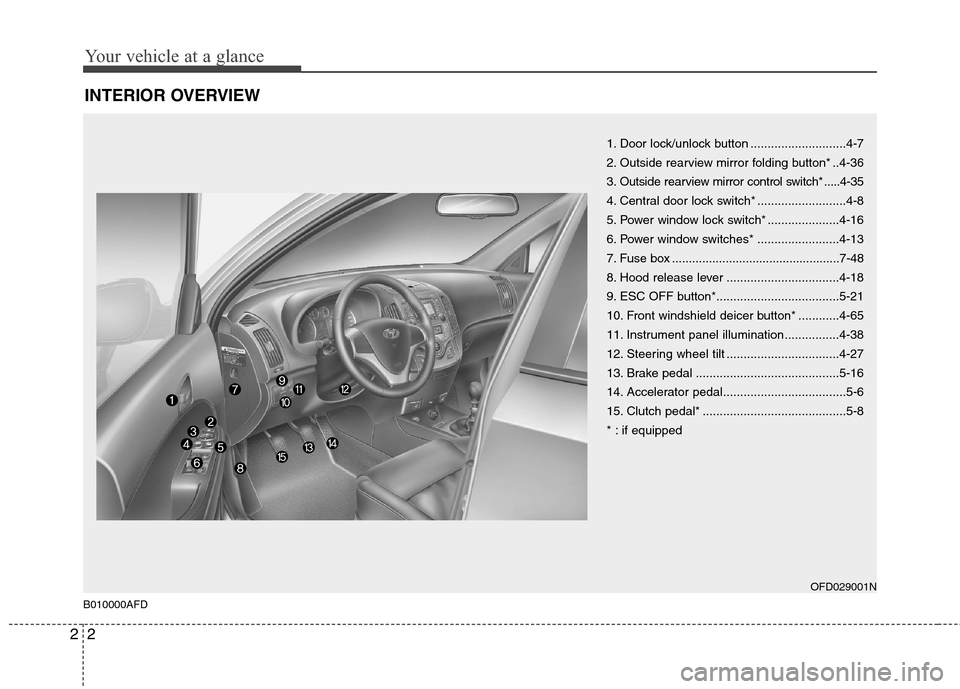
Your vehicle at a glance
2 2
INTERIOR OVERVIEW
1. Door lock/unlock button ............................4-7
2. Outside rearview mirror folding button* ..4-36
3. Outside rearview mirror control switch* .....4-35
4. Central door lock switch* ..........................4-8
5. Power window lock switch* .....................4-16
6. Power window switches* ........................4-13
7. Fuse box ..................................................7-48
8. Hood release lever .................................4-18
9. ESC OFF button*....................................5-21
10. Front windshield deicer button* ............4-65
11. Instrument panel illumination................4-38
12. Steering wheel tilt .................................4-27
13. Brake pedal ..........................................5-16
14. Accelerator pedal....................................5-6
15. Clutch pedal* ..........................................5-8
* : if equipped
OFD029001N
B010000AFD
Page 16 of 402
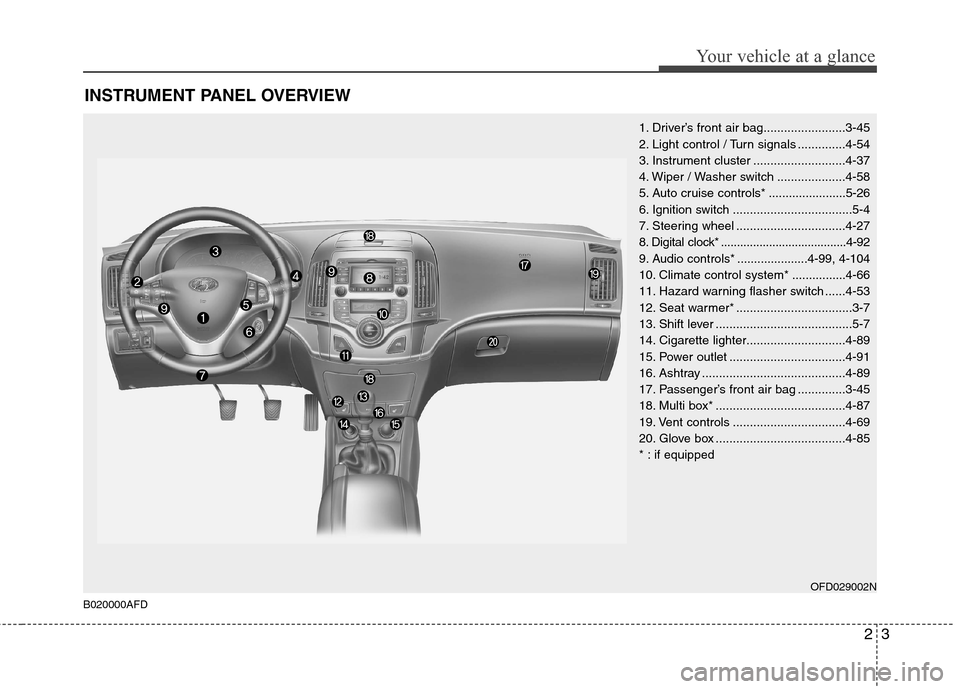
INSTRUMENT PANEL OVERVIEW
1. Driver’s front air bag........................3-45
2. Light control / Turn signals ..............4-54
3. Instrument cluster ...........................4-37
4. Wiper / Washer switch ....................4-58
5. Auto cruise controls* .......................5-26
6. Ignition switch ...................................5-4
7. Steering wheel ................................4-27
8. Digital clock* .......................................4-92
9. Audio controls* .....................4-99, 4-104
10. Climate control system* ................4-66
11. Hazard warning flasher switch ......4-53
12. Seat warmer* ..................................3-7
13. Shift lever ........................................5-7
14. Cigarette lighter.............................4-89
15. Power outlet ..................................4-91
16. Ashtray ..........................................4-89
17. Passenger’s front air bag ..............3-45
18. Multi box* ......................................4-87
19. Vent controls .................................4-69
20. Glove box ......................................4-85
* : if equipped
OFD029002N
B020000AFD
23
Your vehicle at a glance
Page 17 of 402
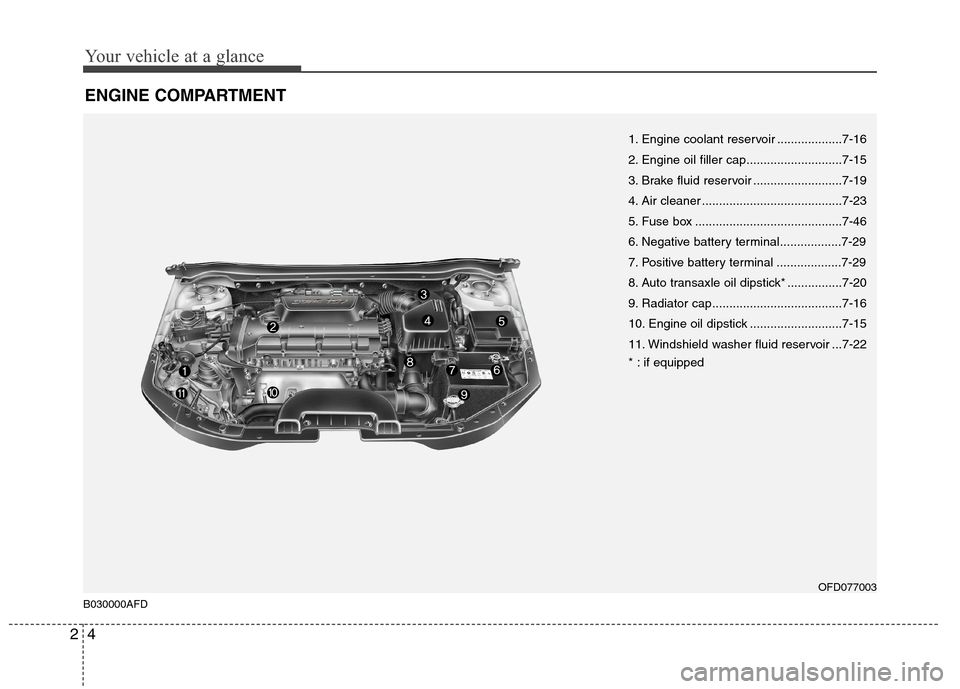
Your vehicle at a glance
4 2
ENGINE COMPARTMENT
OFD077003
1. Engine coolant reservoir ...................7-16
2. Engine oil filler cap............................7-15
3. Brake fluid reservoir ..........................7-19
4. Air cleaner .........................................7-23
5. Fuse box ...........................................7-46
6. Negative battery terminal..................7-29
7. Positive battery terminal ...................7-29
8. Auto transaxle oil dipstick* ................7-20
9. Radiator cap......................................7-16
10. Engine oil dipstick ...........................7-15
11. Windshield washer fluid reservoir ...7-22
* : if equipped
B030000AFD
Page 18 of 402
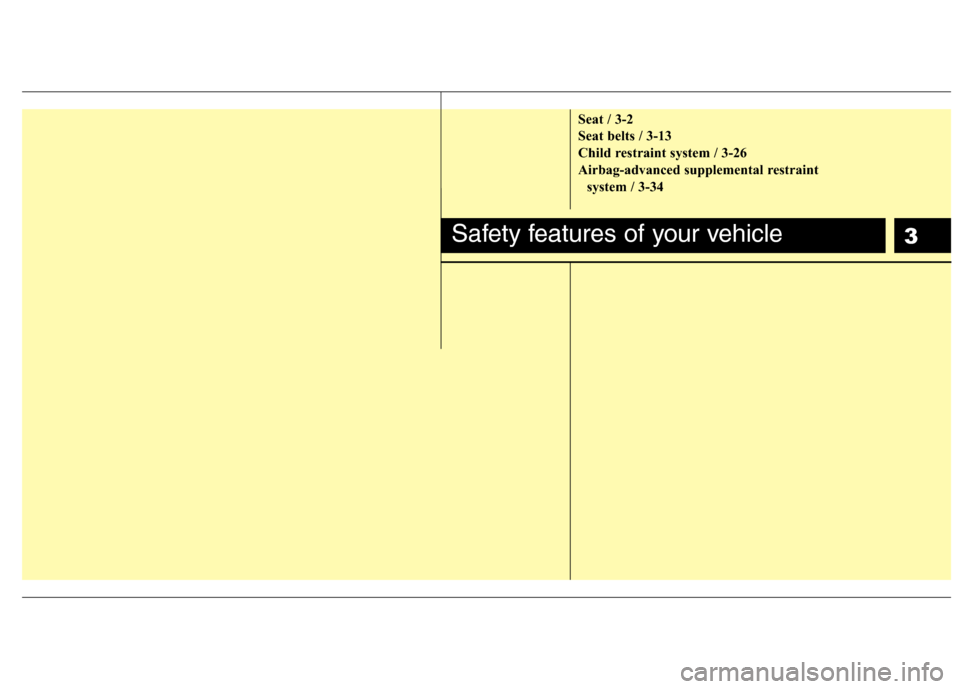
3
Seat / 3-2
Seat belts / 3-13
Child restraint system / 3-26
Airbag-advanced supplemental restraint
system / 3-34
Safety features of your vehicle
Page 19 of 402
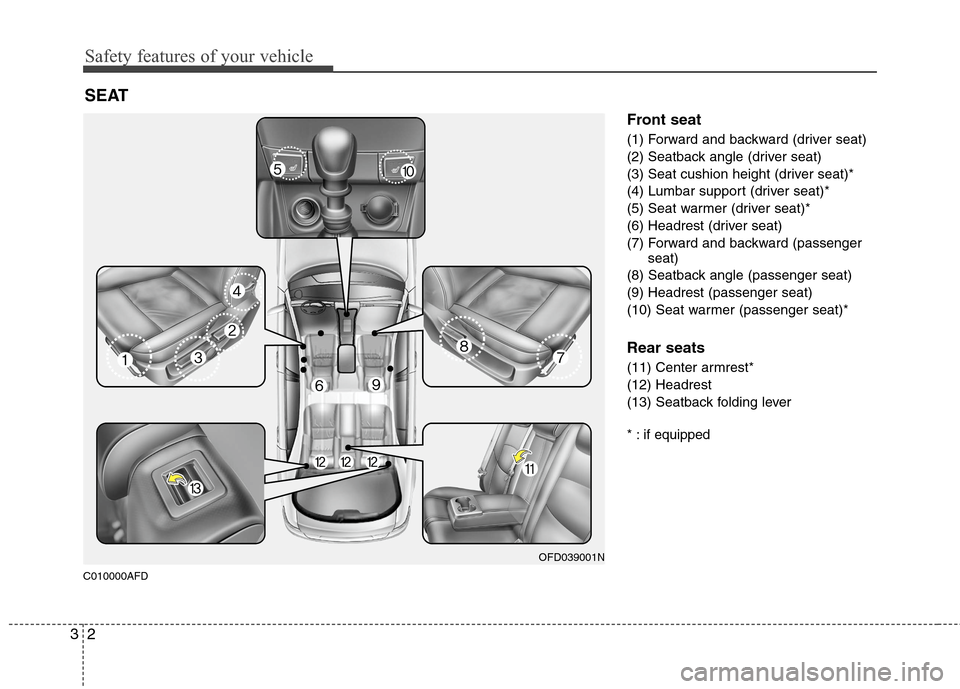
Safety features of your vehicle
2 3
C010000AFD
Front seat
(1) Forward and backward (driver seat)
(2) Seatback angle (driver seat)
(3) Seat cushion height (driver seat)*
(4) Lumbar support (driver seat)*
(5) Seat warmer (driver seat)*
(6) Headrest (driver seat)
(7) Forward and backward (passenger
seat)
(8) Seatback angle (passenger seat)
(9) Headrest (passenger seat)
(10) Seat warmer (passenger seat)*
Rear seats
(11) Center armrest*
(12) Headrest
(13) Seatback folding lever
* : if equipped
SEAT
OFD039001N
Page 20 of 402
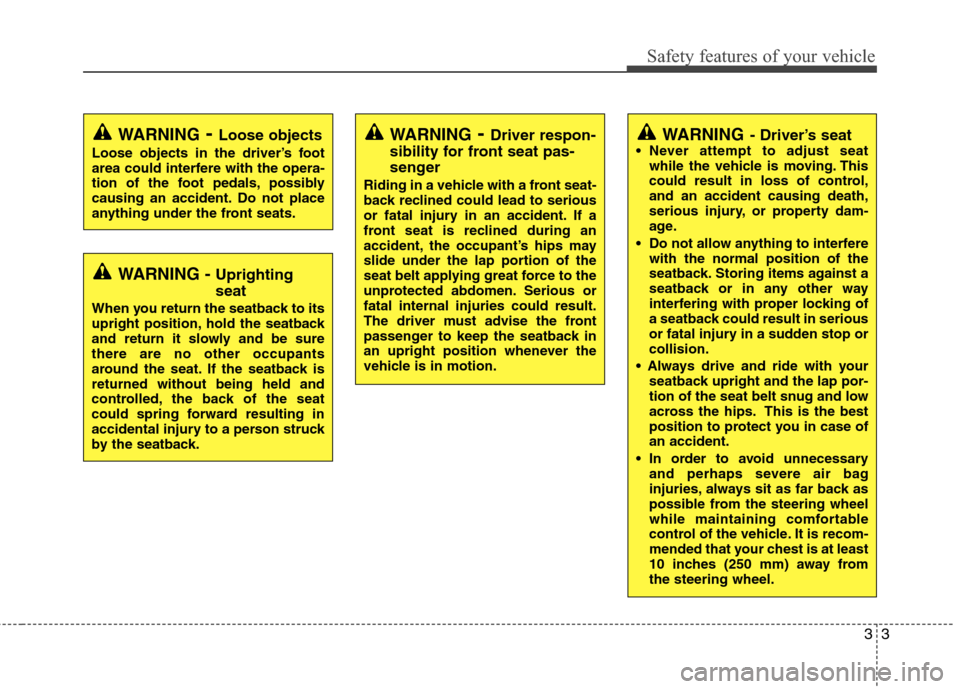
33
Safety features of your vehicle
WARNING- Driver’s seat Never attempt to adjust seat
while the vehicle is moving. This
could result in loss of control,
and an accident causing death,
serious injury, or property dam-
age.
Do not allow anything to interfere
with the normal position of the
seatback. Storing items against a
seatback or in any other way
interfering with proper locking of
a seatback could result in serious
or fatal injury in a sudden stop or
collision.
seatback upright and the lap por-
tion of the seat belt snug and low
across the hips. This is the best
position to protect you in case of
an accident.
In order to avoid unnecessary
and perhaps severe air bag
injuries, always sit as far back as
possible from the steering wheel
while maintaining comfortable
control of the vehicle. It is recom-
mended that your chest is at least
10 inches (250 mm) away from
the steering wheel.
WARNING - Uprighting
seat
When you return the seatback to its
upright position, hold the seatback
and return it slowly and be sure
there are no other occupants
around the seat. If the seatback is
returned without being held and
controlled, the back of the seat
could spring forward resulting in
accidental injury to a person struck
by the seatback.
WARNING- Loose objects
Loose objects in the driver’s foot
area could interfere with the opera-
tion of the foot pedals, possibly
causing an accident. Do not place
anything under the front seats.
WARNING- Driver respon-
sibility for front seat pas-
senger
Riding in a vehicle with a front seat-
back reclined could lead to serious
or fatal injury in an accident. If a
front seat is reclined during an
accident, the occupant’s hips may
slide under the lap portion of the
seat belt applying great force to the
unprotected abdomen. Serious or
fatal internal injuries could result.
The driver must advise the front
passenger to keep the seatback in
an upright position whenever the
vehicle is in motion.